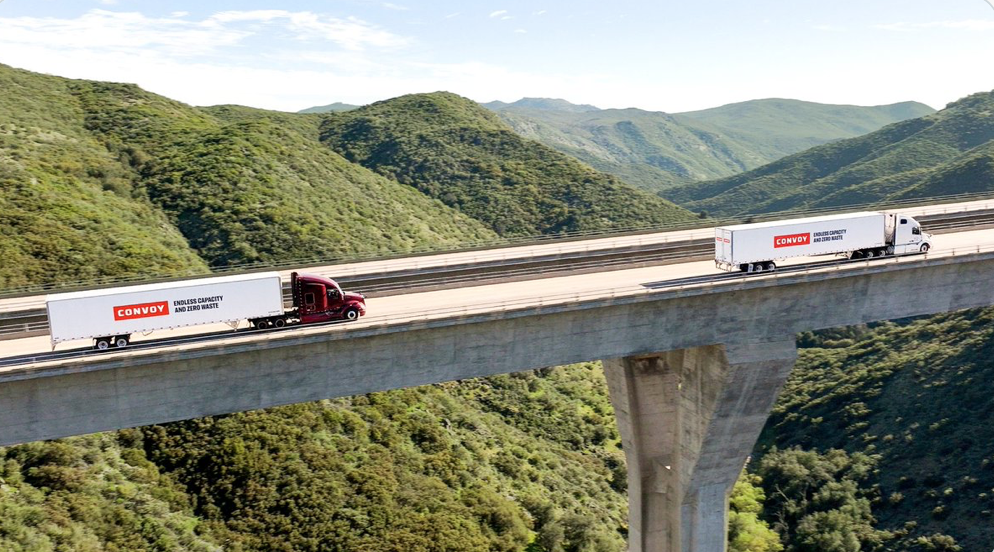Freight matching apps gain momentum as Convoy raises $260 million
Logistics tech startups look to consolidate market share as investor funding continues flowing into freight industry.

Digital trucking network provider Convoy plans to accelerate the development of its freight-matching app in response to surging customer demand after raising $260 million in financial backing, the firm said today.
That burst of fresh funding is just the latest example of investors pumping cash into the logistics sector, and could lead to a rising tide of consolidation as tech-driven startups gain increasing traction in their mission to absorb market share from older incumbents, a Convoy executive said.
The Seattle firm raised its new money through a $160 million “series E” preferred equity round led by Baillie Gifford and T. Rowe Price and a $100 million venture-debt investment from Hercules Capital Inc. The company has also secured a $150 million line of credit from J.P. Morgan. In total, the moves value Convoy at $3.8 billion.
Convoy leaders acknowledged that the nation’s freight networks have been stumbling through chaotic conditions during the pandemic, but said their technology offers a flexible system that supports elastic capacity that is appropriate to any economic cycle.
“We’ve seen some softening but the market has been riding an exceptional high since a few months after the start of Covid in mid-2020. No one knows where the market is going. What we do know is that productivity matters regardless of market conditions,” Convoy co-founder and CEO Dan Lewis said in an email.
“Right now we’re at yet another challenging point for the U.S. supply chain—logistics leaders have been through one of the most volatile periods in freight history and drivers are being squeezed by record-high fuel prices that have nearly doubled year-over-year. Businesses that run the most efficiently will be better positioned to thrive when the market is tight and when the market is soft,” Lewis said.
According to Convoy, its smartphone app connects shippers and freight brokers to a nationwide network of 400,000 trucks. Convoy says the result is truly “elastic” truckload freight capacity, allowing goods to be moved more efficiently and reducing the number of empty miles driven by truckers. That approach is particularly effective for small fleets—operating six or fewer trucks—which are typically the businesses most impacted by market fluctuation, the firm said.
That approach works just as well when trucking capacity is loose as when it’s tight, Lewis said. “We saw this play out in early 2019 as the market loosened after a very tight 2017-2018 period. Technology is the only path to scale flexibly with demand or to automatically adjust when demand decreases. Just as the cloud revolutionized the elastic capacity model for computing, machine learning and automation are revolutionizing elastic capacity for freight.”
Because its platform is designed to function just as well during both fat and lean times, Convoy said tech-based logistics firms are ascendant in a freight industry has historically underinvested in technology.
“We expect to see some consolidation. It will be less about combining digital players, and more about tech-led companies consolidating business from traditional incumbents, unable to keep up with the rapid pace of innovation and advancements taking place in the industry,” Lewis said. “Solutions built on technology and data deliver a better customer experience, lower costs, and improve sustainability—and that’s not something people will fight against. Those that stop innovating and ignore what their customers want, will fail.”
Recent months have seen investors from private equity and venture capital firms have been buying ownership shares in some logistics tech firms and acquiring others outright to roll them into mergers of multiple startups. The trend has touched areas from systems integrators like MHS Global and Fortna to 3PLs like RK Logistics, and from connected vehicle data platforms like Rand McNally and final mile delivery networks like Capital Express and ADL Delivery.
Today we announced our Series E funding round. Great insights from our CEO and co-founder on the state of our industry and where we’re headed next. https://t.co/LwLSLe8HYj
— Convoy (@convoyteam) April 21, 2022
Related Articles

Copyright ©2024. All Rights ReservedDesign, CMS, Hosting & Web Development :: ePublishing